Exploring San Gimignano in Tuscany
This post may contain affiliate links to products or services I'm happy to recommend. If you click on an affiliate link and then make a purchase, Artsy Traveler may earn a small commission at no cost to you. Thank you!
San Gimignano is Tuscany’s city of towers and an entrancing place that I never tire of exploring. I’ve visited San Gimignano numerous times and even set my first novel there (The Towers of Tuscany).

I’ve nowhere near stopped loving it!
San Gimignano Snapshot
Yes, you’ll find plenty of crowds in San Gimignano, especially on hot summer days, and lots of tourist dreck in the shops. But unlike some of Italy’s most visited cities (think Florence!), San Gimignano manages to retain its medieval charm.
Even if you visit San Gimignano on the most tourist-heavy days, you need only walk a few paces away from the main thoroughfare (Via San Giovanni) to find yourself virtually alone in a quiet back street. Hear birds twittering and watch an old guy sweeping his front stoop.
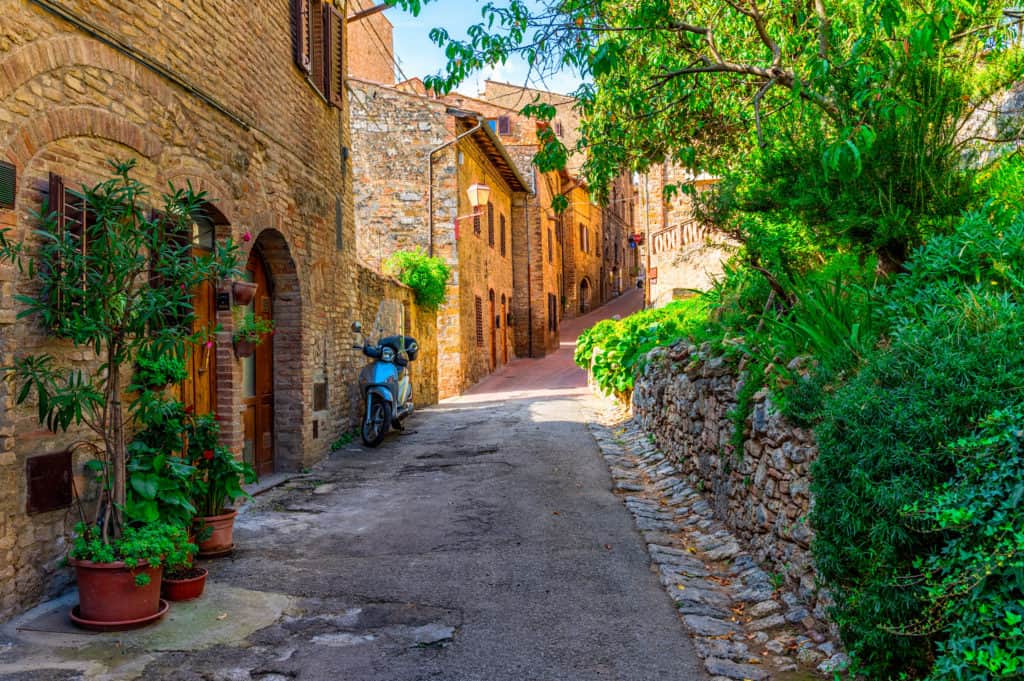
The heaving, sweating, shopping masses of humanity packing the piazzas and dripping gelato on the cobblestones are a distant memory.
Welcome to the 14th Century
You’re in the 14th century! Your long gown swishes around your legs, you listen for the bells that divide your days and regulate your life.
If you’re a woman, you might be on your way to the baker for a loaf of fresh bread or to the church to make confession. If you’re a man, you could be meeting a kinsman to settle a festering vendetta or to chat with a fellow guild member about the crocus trade.
In the Middle Ages, much of San Gimignano’s wealth came from the cultivation of saffron from the stamens of crocuses. Also lucrative was textile manufacturing and the production of Vernaccia, a lovely white wine still produced today (it’s very good!).
Walk up to the ruined fortezza where you’ll rarely find many tourists and enjoy this stunning view of the towers of San Gimignano.
When you walk the back streets of San Gimignano in the 21st century, you are only an ounce of imagination away from the Middle Ages.
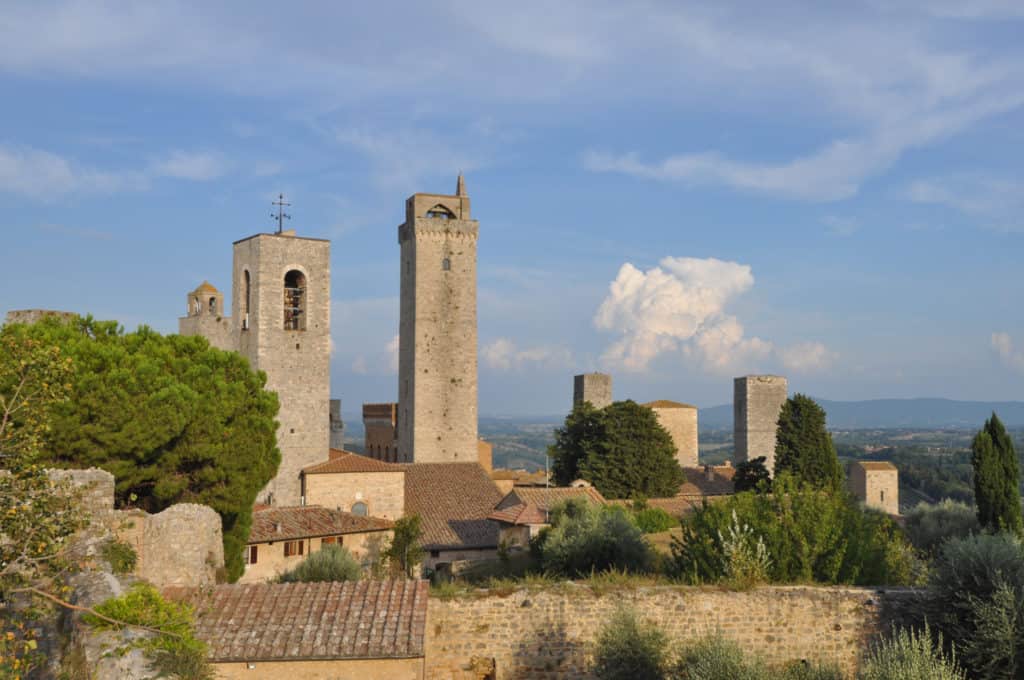
The Towers of San Gimignano
San Gimignano is called the Tuscan city of towers because 14 medieval towers are still standing. In its heyday in the 14th century, over 72 towers dominated San Gimignano’s skyline.
Why So Many Towers?
Every medieval city had towers back in the day, but San Gimignano is unique because so many of its towers remain. Why so many towers? We can safely assume that the medieval merchants didn’t build them to give 21st-century tourists something to point their iPhones at.
Wealthy citizens frequently competed with each other to build the tallest towers above their homes. In fact, the Podesta passed a law prohibiting any private citizen from building a tower higher than the Torre Grossa, the municipal hall which survives to this day.
The citizens of San Gimignano were a bellicose lot who sometimes attacked and destroyed towers belonging to their rivals. The family feuds that form the basis of the Romeo and Juliet story were definitely not fiction. Vendetta and its accompanying violence were the all-too-common ways to resolve differences.
History of San Gimignano
The Etruscans first settled San Gimignano in the 4th century BC. Significant growth did not occur until 1000 to 1200. Thanks to its proximity to the Via Francigena, a major route across Italy, San Gimignano was an important stopover for travelers, pilgrims, and merchants. The town became steadily more prosperous until it declared itself a free Commune in 1199.
In 1300, Dante Alighieri came to San Gimignano, and in 1317 the famous painter Lippo Memmi opened a workshop. With his father, Lippo Memmi painted a fresco cycle in the town hall that you can see today. I include the frescoes in my post on Ten Must-See Masterpieces in Tuscany and below – see Frescoes, Frescoes, and More Frescoes.
San Gimignano prospered until the mid-14th century when in 1348 it was devastated by the plague, also known as the Black Death. More than half of the population died in a six-month period.
Following the pestilence that also ravaged most of western Europe, San Gimignano never recovered its former glory and at the end of the 14th century was finally obliged to submit to Florentine rule.
The town’s website provides an excellent overview of San Gimignano’s rise and fall over the centuries.
What To See in San Gimignano
San Gimignano’s main attraction is the town itself–the cobbled streets, the towers, the Tuscan ambience. But you’ll also find several worthwhile attractions to explore, including my favorite, San Gimignano 1300.
San Gimignano 1300
The San Gimignano 1300 museum contains an amazing scale model of San Gimignano as it appeared in the year 1300 with its 72 towers intact.
Not long after I started my novel, The Towers of Tuscany, about a woman painter in the 14th century, I came across the website for San Gimignano 1300. I could not believe my luck! Someone had very thoughtfully recreated the entire city in which much of the novel’s action takes place.
I had to see it! A few months after I found San Gimignano 1300 on the web, I was there in person. Few things get in the way of an historical novelist on a research warpath!
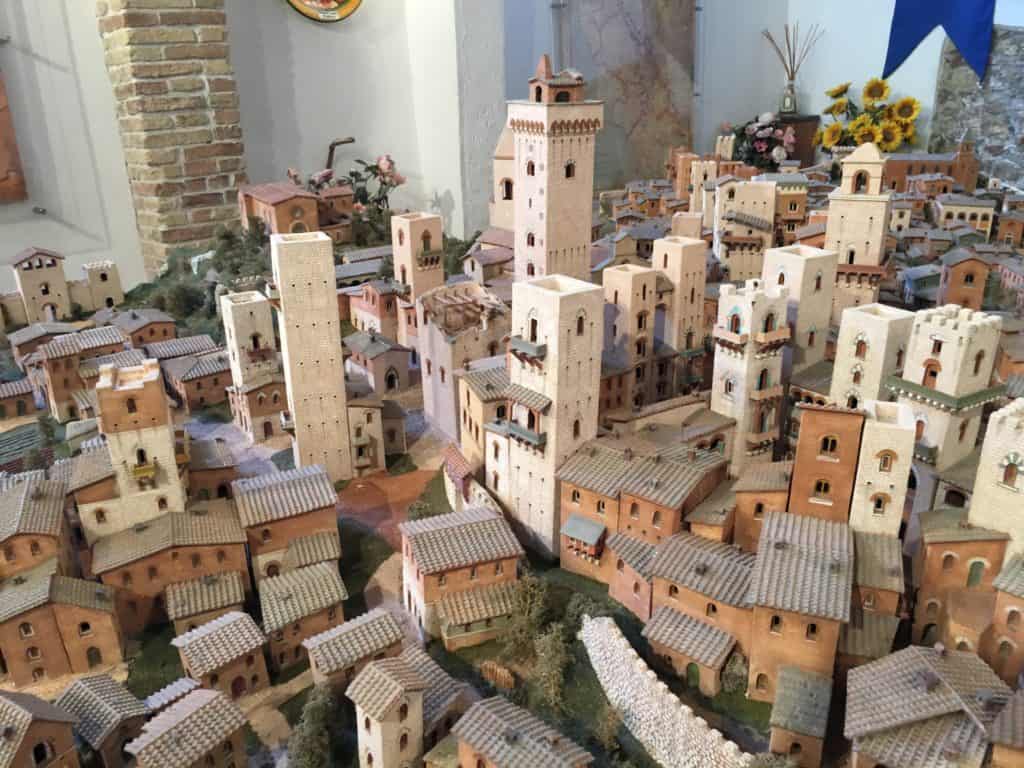
San Gimignano 1300 moved to a smaller venue a few years after I first saw it. The model is now divided into two sections, but you still get a good sense of how the city must have looked in 1300.
The staff at San Gimignano 1300 are lovely. I’ve returned several times in the last few years to replenish their supply of The Towers of Tuscany.
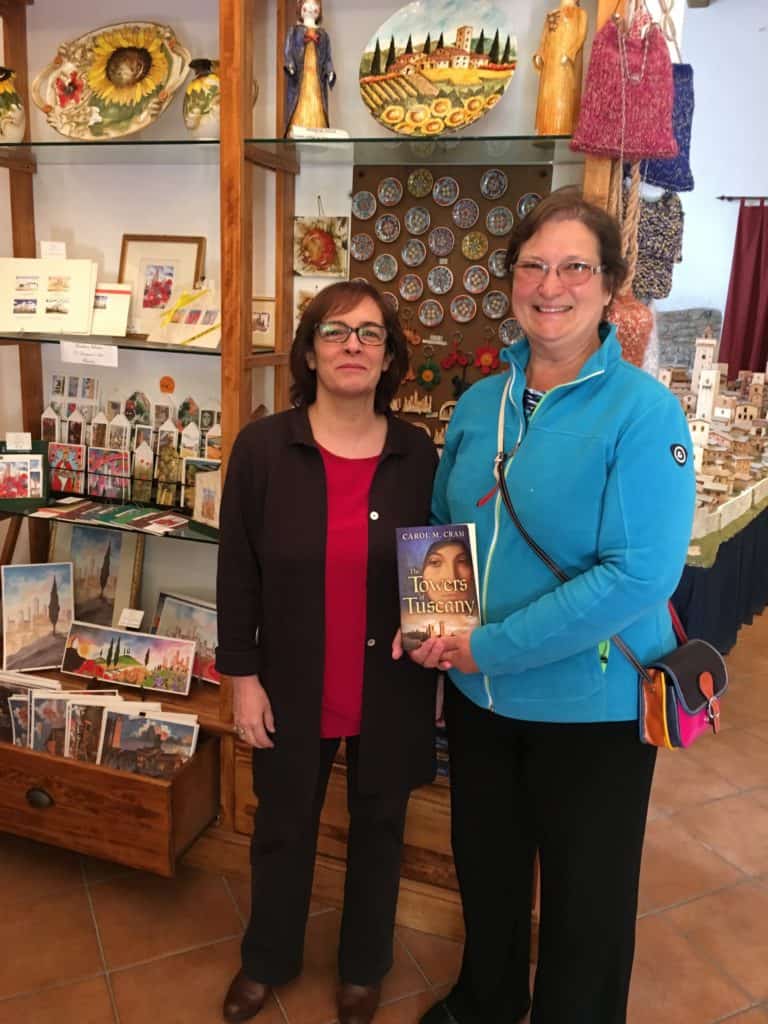
Frescoes, Frescoes, and More Frescoes
Unlike many Italian towns, San Gimignano is stuck in a medieval time warp. Most of the best art was created during the Middle Ages rather than the Renaissance. I’m a medieval girl at heart and prefer the flatter, more stylized work of the medieval painters to the florid, somewhat over-produced paintings of the Renaissance.
Museo Civico
The first stop for art lovers should be the frescoes in the Museo Civico. Painted by Memmo de Filippuccio and his son Lippo Memmi in 1317, the frescoes portray scenes of everyday life. Such scenes were a rarity at a time when the vast majority of frescoes and paintings depicted religious subjects.
I like best the two scenes showing a newly married couple first enjoying a communal bath together (ooh la la) and then climbing into bed.
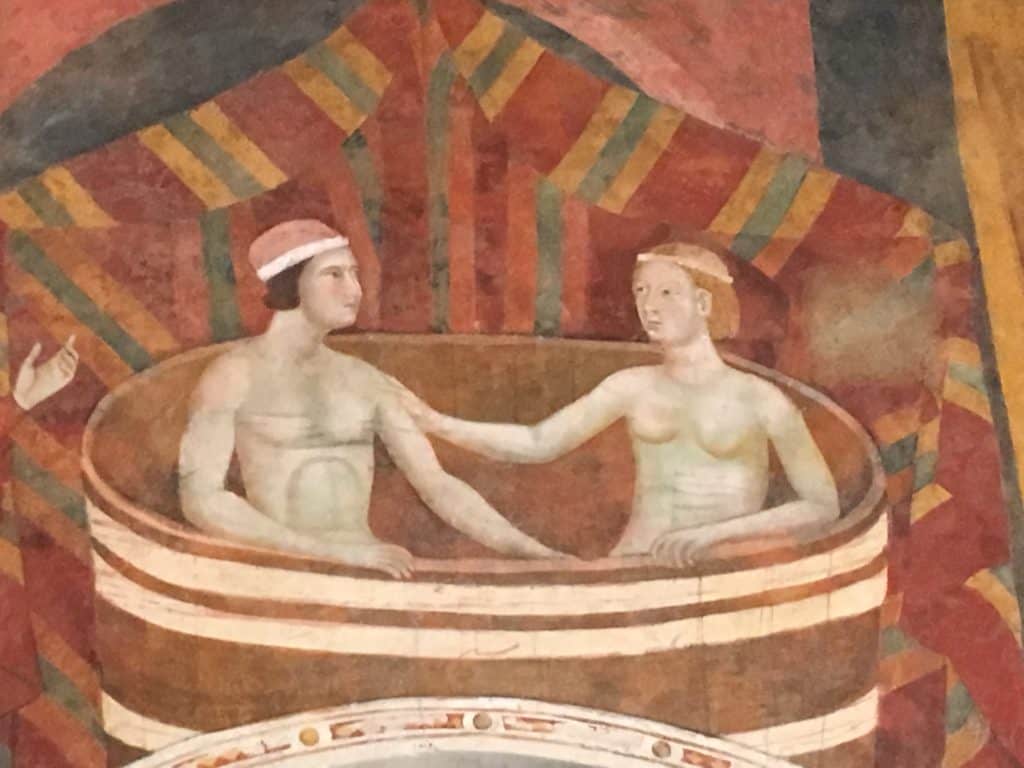
The scene depicting the couple getting into bed shows them as naked. While researching The Towers of Tuscany, I learned that people often slept naked to get a break from the wee beasties that infested their heavy gowns. Also, I imagine that summers in San Gimignano were as hot in the 14th century as they are today.
Another fabulous fresco in the Museo Civico is The Maestà by Lippo Memmi. Commissioned in 1317, the fresco is said to have been inspired by Simone Martini’s Maestà from the Palazzo Pubblico in Siena. The fresco shows Mary seated on a throne surrounded by adoring saints and angels.
Frescoes in the Duomo
Other frescoes worth seeing in San Gimignano cover the walls of the Duomo in the Piazza Duomo in the town center. One set, painted by Bartolo di Fredi in 1356, depicts scenes from the Old Testament. I particularly like the figure of Noah lying drunk on the ground, his gown open to reveal that he is definitely not wearing his boxer shorts. There’s nothing new under the sun!
Another set of frescoes depicting Hell was painted by Benozzo Gozzoli in 1465. The frescoes are terrifyingly realistic. You might want to avoid them if you’re traveling with children.
Torre Grossa
The tallest tower in San Gimignano, at 54 meters (178 feet), is the Torre Grossa, part of the Palazzo Comunale where the Museo Civico is housed. It’s worth the effort to climb to the top and see the stunning view. If it’s a fine day, go early or late to avoid the crowds.
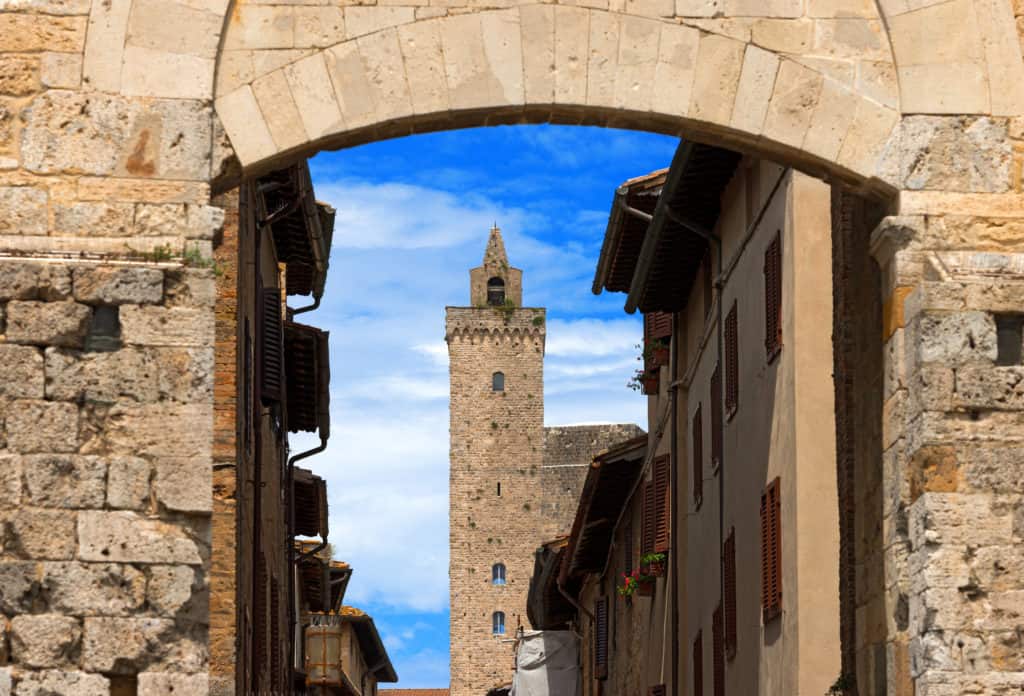
San Gimignano at Night
Ahhhh….! The tour buses have puffed their way down the hill, the shops are shuttered, and peace descends. Thanks to floodlit towers, the darkness never gets close to the black intensity of the olden days, but your imagination can still get a workout.
Enjoy a lovely meal at one of San Gimignano’s restaurants and then walk off the pasta and wine with a stroll through the quiet piazzas. The later it gets, the quieter the streets become. And, unlike in the 14th century, walking the streets of San Gimignano after dark is not dangerous. No assassins are intent on revenging a vendetta; no watchmen are standing by to clamp into irons people ignoring curfews.
Some guides to San Gimignano mention the two torture museums. I don’t get the point of these sensationalist “attractions” and avoid them at all costs.
Yes, we know punishments were harsh in the Middle Ages. They’re no picnic nowadays in many parts of the world, but I doubt we help matters much by ogling gruesome displays of pain. I say don’t give them your euros.
San Gimignano is best enjoyed over at least two days and one night. Most bus tours pop in and out for a few hours, staying just long enough for people to sip a cappuccino, climb a tower, and go shopping.
If you really want to experience San Gimignano, stay a few days, preferably at one of the lovely hotels in the nearby countryside.
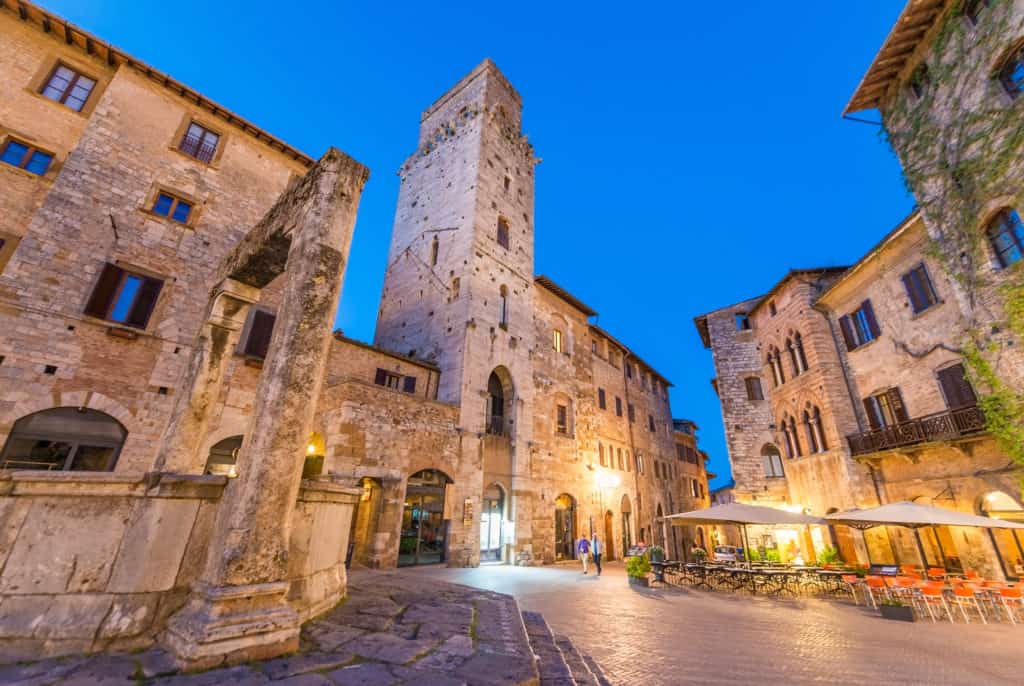
For accommodation recommendations, see Where to Stay in Italy.
The Towers of Tuscany
San Gimignano is one of two main settings in my novel, The Towers of Tuscany. Here’s what my main character, Sofia Carelli, thinks about San Gimignano after an afternoon spent painting in secret at the top of one of the towers:
Sofia pushed back from the table and rose to her feet. Massaging with one hand a knot in her shoulder, she stepped to the narrow window. Between the two closest towers, the countryside beyond the town was just visible as a slit of green and gold.
The commune of San Gimignano fairly bristled with towers. Just the other day, Sofia had counted more than seventy. Day after day, the pounding and clanging of endless construction filled the air, along with dust so thick that on windless afternoons citizens squinted across the Piazza della Cisterna.
The best times to visit San Gimignano are late spring when the surrounding countryside is drenched in the freshest greens imaginable and in September/October when golden light and crisp days make sightseeing a pleasure.
Just remember to take along a rain jacket and a sweater.
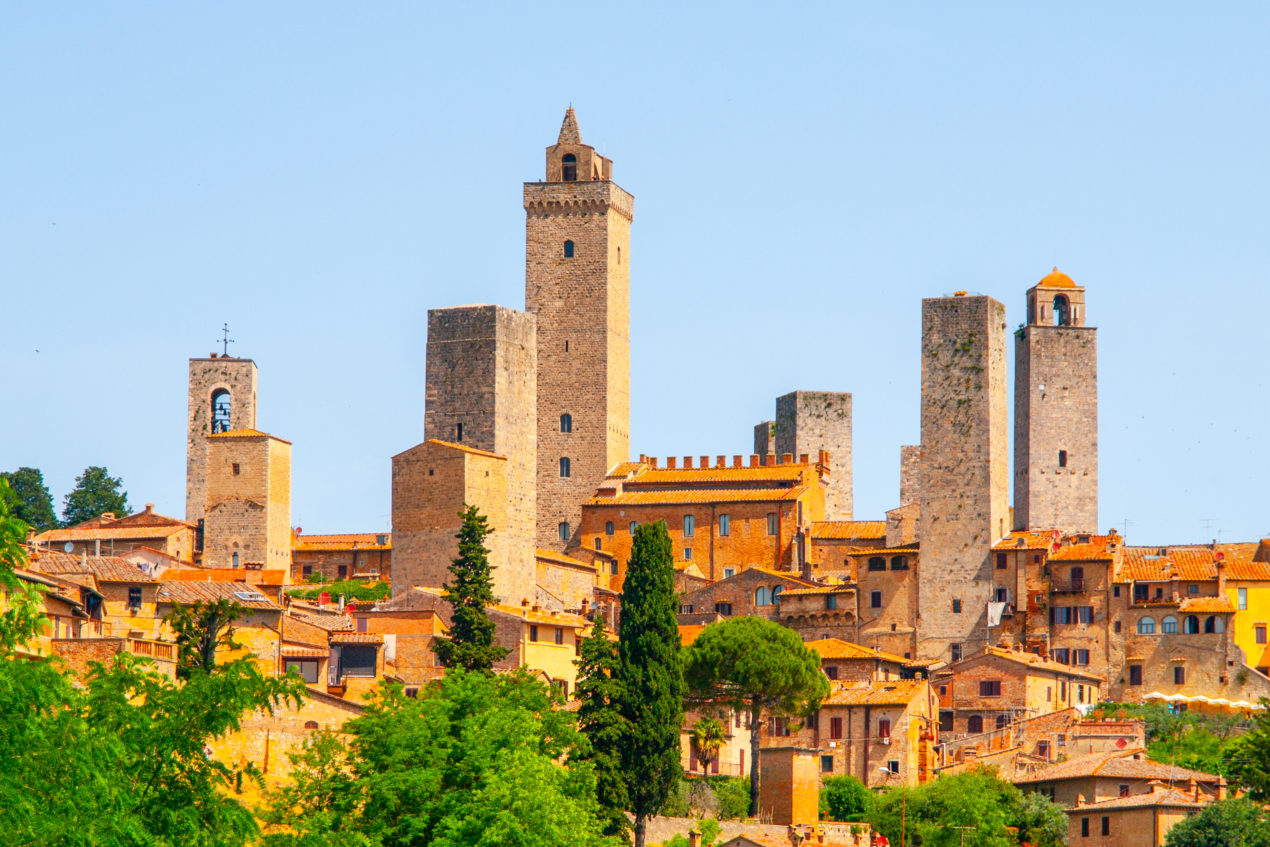
[…] San Gimignano […]
[…] plenty of recommendations and suggestions, read Exploring Tuscany, Umbria and La Dolce Vita and Exploring San Gimignano in Tuscany. Also check out Art Masterpieces in Tuscany Who Don’t Want to […]
[…] For an in-depth look at San Gimignano and why it deserves top billing in your itinerary, read Exploring San Gimignano in Tuscany. […]
[…] us have ever visited Montepulciano and so decided that on this trip we’d skip our usual visits to San Gimignano and Siena and see something new. Good […]